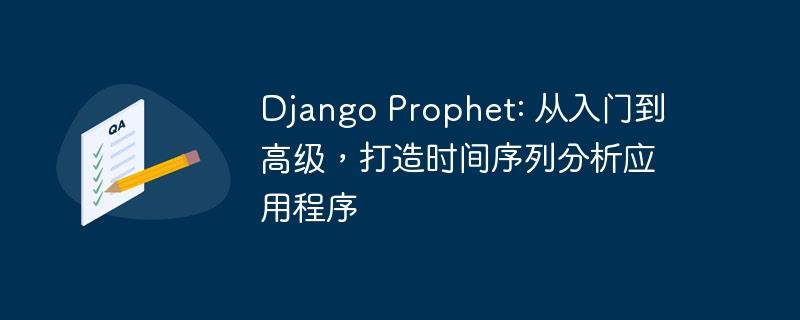
Django Prophet: 从入门到高级,打造时间序列分析应用程序,需要具体代码示例
时间序列分析是一种重要的统计分析方法,用于研究时间序列数据的变化趋势、周期性、季节性和异常值等。随着数据科学和机器学习的发展,时间序列分析在预测、研究市场趋势和经济指标等领域中愈发重要。
Django Prophet是一个基于Python的时间序列分析工具,它结合了统计学方法和机器学习技术,提供了简单易用且高度可定制的时间序列预测功能。本文将介绍如何使用Django Prophet构建一个时间序列分析应用程序,并提供具体的代码示例。
- 安装Django Prophet
首先,我们需要安装Django Prophet。打开终端或命令提示符,运行以下命令:
pip install django-prophet
- 创建Django项目
接下来,我们需要创建一个Django项目。在命令行中运行以下命令:
django-admin startproject timeseries_app cd timeseries_app
- 创建Django应用程序
在timeseries_app目录下运行以下命令,创建一个名为timeseries的Django应用程序:
python manage.py startapp timeseries
然后在settings.py文件中的INSTALLED_APPS列表中添加'timeseries',如下所示:
INSTALLED_APPS = [
...
'timeseries',
...
]- 创建时间序列模型
在timeseries目录下创建一个models.py文件,定义一个名为TimeSeries的模型类,如下所示:
from django.db import models
class TimeSeries(models.Model):
timestamp = models.DateTimeField()
value = models.FloatField()
def __str__(self):
return self.timestamp.strftime('%Y-%m-%d %H:%M:%S')此模型类包含了两个字段:timestamp和value,分别表示时间戳和对应的值。
- 数据准备
在Django项目中,我们通常使用Django管理后台来管理数据。在timeseries目录下的admin.py文件中编写以下代码,以便能够在管理后台中添加和管理TimeSeries模型的数据:
from django.contrib import admin from timeseries.models import TimeSeries admin.site.register(TimeSeries)
- 数据上传
启动Django开发服务器并登录到管理后台,上传时间序列数据。在浏览器中输入以下URL:
http://localhost:8000/admin
然后使用管理员账号登录后,点击"Time series"链接,在页面右上方点击"ADD"按钮,添加一个时间序列对象。
- 时间序列分析
接下来,我们将在视图函数中编写代码,对上传的时间序列数据进行分析和预测。打开timeseries/views.py文件,并添加以下代码:
from django.shortcuts import render
from timeseries.models import TimeSeries
def analyze_time_series(request):
time_series = TimeSeries.objects.all()
# 将时间序列数据整理为Prophet所需的格式
data = []
for ts in time_series:
data.append({'ds': ts.timestamp, 'y': ts.value})
# 使用Django Prophet进行时间序列分析和预测
from prophet import Prophet
model = Prophet()
model.fit(data)
future = model.make_future_dataframe(periods=365)
forecast = model.predict(future)
# 将分析结果传递到模板中进行展示
context = {
'time_series': time_series,
'forecast': forecast,
}
return render(request, 'analyze_time_series.html', context)在上述代码中,我们首先从数据库中获取所有的时间序列数据,并将其整理为Django Prophet所需的格式。然后创建一个Prophet实例,对数据进行拟合和预测。最后,将分析结果传递给模板。
- 模板设计
创建一个名为analyze_time_series.html的模板文件,用于展示时间序列的分析结果。编写以下HTML代码:
<!DOCTYPE html>
<html>
<head>
<title>Analyze Time Series</title>
</head>
<body>
<h1>Time Series Data</h1>
<ul>
{% for ts in time_series %}
<li>{{ ts }}</li>
{% empty %}
<li>No time series data available.</li>
{% endfor %}
</ul>
<h1>Forecast</h1>
<table>
<tr>
<th>Timestamp</th>
<th>Predicted Value</th>
<th>Lower Bound</th>
<th>Upper Bound</th>
</tr>
{% for row in forecast.iterrows %}
<tr>
<td>{{ row.ds }}</td>
<td>{{ row.yhat }}</td>
<td>{{ row.yhat_lower }}</td>
<td>{{ row.yhat_upper }}</td>
</tr>
{% endfor %}
</table>
</body>
</html>在上述模板中,我们使用Django提供的模板引擎,展示时间序列数据和预测结果。
- URL配置
最后一步是配置URL路由,使得我们能够通过浏览器访问分析页面。在timeseries_app目录下的urls.py文件中添加以下代码:
from django.contrib import admin
from django.urls import path
from timeseries.views import analyze_time_series
urlpatterns = [
path('admin/', admin.site.urls),
path('analyze/', analyze_time_series),
]- 运行应用程序
现在可以运行Django应用程序并查看时间序列分析结果了。在命令行中运行以下命令:
python manage.py runserver
然后在浏览器中输入以下URL:
http://localhost:8000/analyze
你将看到时间序列数据和预测结果的页面。
以上就是使用Django Prophet从入门到高级打造时间序列分析应用程序的全部内容。希望本文能为你提供有关时间序列分析和Django Prophet的实际代码示例,并帮助你进一步探索时间序列分析的世界。
